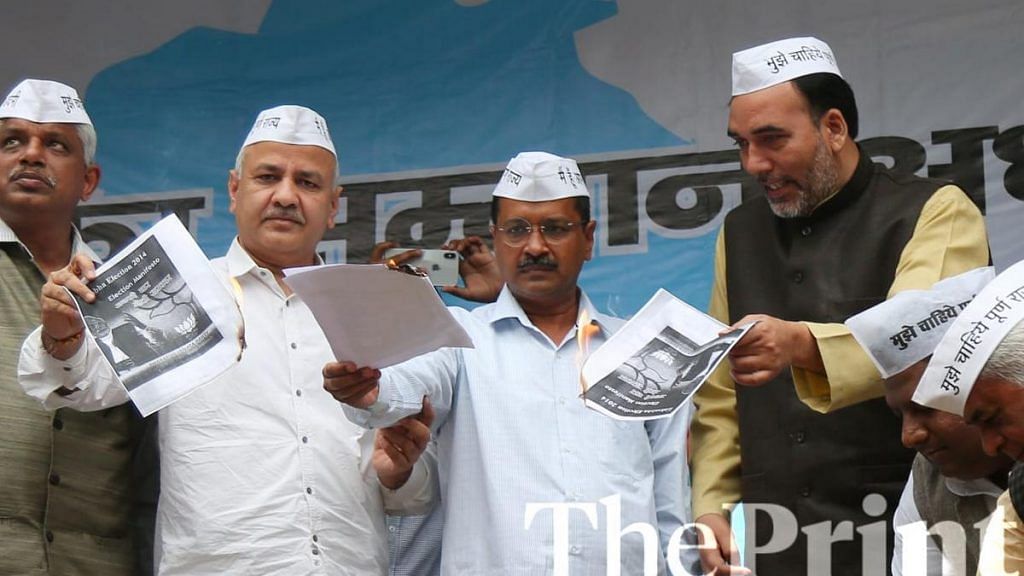New Delhi: The Aam Aadmi Party (AAP) and the Bharatiya Janata Party (BJP) have once again locked horns over the Baniya or trader community in New Delhi, an issue that both parties had sparred over in December.
The latest flashpoint came Wednesday when the leader of the opposition in the Delhi assembly, the BJP’s Vijender Gupta, referred to Chief Minister Arvind Kejriwal’s “khandaan (family)” while slamming the Delhi government in the row over the alleged mass deletion of voters’ names from Delhi’s electoral rolls.
“Your disgusting actions and politics of lies show what family you belong to,” Gupta said.
It prompted Kejriwal to construe it as an attack against the “Aggarwal community”.
“The Aggarwal community has been integral to the progress of this country,” the CM tweeted in response. “Do not drag the Aggarwal community into your dirty politics.”
विजेंदर जी, आपकी मुझसे लड़ाई है। जो कहना है मुझे कहिए, मेरे ख़ानदान को गाली मत दीजिए। मैं अग्रवाल ख़ानदान से हूँ और इस बात का मुझे गर्व है। अग्रवाल समाज ने देश की तरक़्क़ी में अहं भूमिका निभाई है। अपनी गंदी राजनीति में अग्रवाल समाज को मत घसीटिए। https://t.co/3xFRreajPV
— Arvind Kejriwal (@ArvindKejriwal) March 13, 2019
Also read: AAP will win all 7 Delhi seats in Lok Sabha elections, says Arvind Kejriwal
The alleged voter deletion
The two parties had slugged it out over the deletion of voters in a bid to woo one of Delhi’s most influential communities, the traders or Baniyas, who comprise approximately eight per cent of the city-state’s voters.
In December last year, AAP had accused the BJP of knocking 50 per cent of Delhi’s Baniya voters off the electoral rolls ahead of the 2019 Lok Sabha elections. The BJP responded by accusing the Kejriwal-led party of playing caste politics.
AAP then began making phone calls to voters it claimed had their names deleted from the electoral rolls. Last month, the BJP’s Gupta blamed the AAP government in Delhi for the issue, accusing it of “intentionally” hiding the Delhi chief electoral officer’s reply to the assembly secretariat on the issue.
The AAP claims that traders, known to be BJP voters, had drifted away from the party in light of demonetisation and the goods and services tax (GST), implemented by the Modi government within months of each other.
This discontent, the AAP alleges, led the BJP to axe nearly four lakh of Delhi’s estimated eight lakh Baniya voters in the draft electoral rolls released in September.
An influential vote
The Baniya community is a significant vote bank in Delhi, in no small part because its members are regarded as influential political donors. In the 2015 assembly elections, while seven of the AAP’s 70 candidates were from the community, the BJP fielded nine.
A former AAP politician familiar with the workings of the party and Kejriwal told ThePrint that the party’s argument against the BJP held no water. “The BJP is not stupid enough to try and disenfranchise its own voter base,” the leader said.
“This is an attempt to cultivate a caste-based vote bank. Arvind Kejriwal wants to show the urban middle class, the Baniyas, that he is their leader, not the BJP.”
“Members of the community are seen as hardcore BJP supporters. They are the backbone of the BJP in Delhi,” said another leader familiar with AAP.
“If the AAP can break that, it will result in immense electoral gains. They are one of the dominant castes. They have money, influence and control trade,” he added.
AAP MP Sushil Gupta, however, said the trader community had given up on the BJP.
“The Baniya community did not support the Aam Aadmi Party in 2015,” he said. “But since demonetisation and GST, they have come to realise that the BJP does not represent their interests, that’s why they are being targeted.”
“The BJP is 100 per cent responsible for the deletions,” said Gupta, who also heads the Akhil Bharatiya Agrawal Sangathan, a social group representing the community. “GST and demonetisation have hit the traders hard.”
Former Delhi BJP Satish Upadhyay, meanwhile, said: “Kejriwal is playing divisive politics. It is ironic that he has targeted BJP and the Congress in the past for caste politics. His own mala fide election politics is clearly above reproach.”
Also read: AAP to gherao BJP and Congress offices for 2 days over Delhi statehood demand
Traders’ ire
In the wake of demonetisation, the traders’ ire for the BJP often dominated the political discourse. The issue was one of the mainstays of the opposition’s campaign during the Gujarat assembly elections in December 2017. However, when Surat voted almost en masse for the BJP, it was seen as a sign of the community’s continued support for the party.
The AAP has reportedly been going all out to woo the community. In Delhi’s trading hub of Chandni Chowk, the AAP government recently inaugurated a massive redevelopment project to “restore and renew its glory… And take it to unprecedented heights”.
Kejriwal himself belongs to the Agrawal community. In a controversial move, the AAP also nominated two Baniya community members — N.D. Gupta and Sushil Gupta — to the Rajya Sabha, reportedly at the expense of senior party leaders.
This is not the first time the issue of caste has become a flashpoint between the two parties ahead of elections. In 2015, a BJP ad targeted Kejriwal over his ‘upadravi gotra’ — upadravi translates as one who causes disorder. The AAP subsequently sought an apology, saying the BJP had referred to the entire ‘Agrawal samaj’ as upadravi.
The BJP responded by inducting a number of leaders from the community into its ranks.
